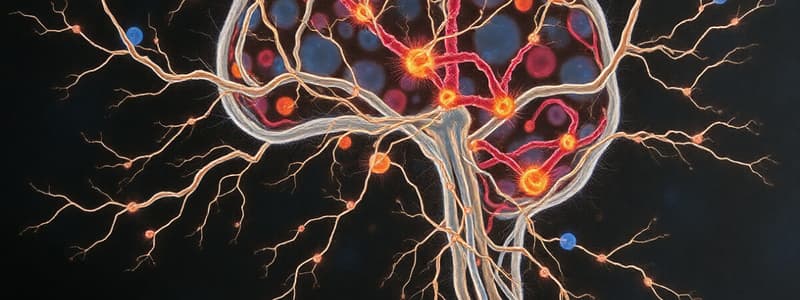Podcast
Questions and Answers
What structure is responsible for collecting sensory input in the nervous system?
What structure is responsible for collecting sensory input in the nervous system?
- Synapse
- Ganglion
- Receptors (correct)
- Neuroglia
Which of the following layers is the outermost covering of the brain?
Which of the following layers is the outermost covering of the brain?
- Dura mater (correct)
- Pia mater
- Arachnoid mater
- Cerebrospinal fluid
Which component is NOT a major region of the human brain?
Which component is NOT a major region of the human brain?
- Brainstem
- Medullary body (correct)
- Cerebellum
- Cerebrum
What best describes the role of the spinal cord in the nervous system?
What best describes the role of the spinal cord in the nervous system?
What term describes a collection of cell bodies of neurons outside the central nervous system?
What term describes a collection of cell bodies of neurons outside the central nervous system?
Flashcards are hidden until you start studying
Study Notes
Basic Functions of the Nervous System
- Sensation: Involves collecting sensory input from the environment through receptors that monitor internal and external stimuli.
- Integration: Processing and interpreting sensory information to determine appropriate responses.
- Reaction: Motor output activation of muscles and glands via neurotransmitters.
Structural Organization of the Nervous System
- Central Nervous System (CNS): Comprises the brain and spinal cord.
- Peripheral Nervous System (PNS): Includes 12 pairs of cranial nerves and 31 pairs of spinal nerves.
Nervous Tissue Composition
- Grey Matter: Contains neuronal cell bodies, short processes, neuroglia, and blood vessels.
- White Matter: Composed of long processes (axons) of neurons.
- Ganglion: A collection of neuron cell bodies located outside the CNS.
- Nucleus: A collection of neuron cell bodies located inside the CNS.
- Plexus: A network formed by a collection of nerve fibers.
Human Brain Structure
- Located in the cranial cavity and divided into four major regions:
- Cerebrum: Consists of two cerebral hemispheres.
- Diencephalon: Includes the thalamus, hypothalamus, subthalamus, and epithalamus.
- Cerebellum: Responsible for coordination and balance.
- Brainstem: Comprises the midbrain and pons.
Spinal Cord Details
- Length: Measures approximately 42-45 cm.
- Location: Situated within the vertebral canal.
- Starts at: Medulla oblongata.
- Ends at: Conus medullaris, terminating at the L2 vertebra.
- Spinal Nerves: Gives rise to 31 pairs.
Protection of the CNS
- Bones: Skull and vertebral column provide primary protection.
- Meninges: Three protective layers surrounding the CNS.
- Cerebrospinal Fluid (CSF): Provides cushioning and nourishment.
Meningeal Coverings
- Dura Mater: The outermost layer.
- Arachnoid Mater: The middle layer.
- Pia Mater: The innermost layer closely adhering to the brain and spinal cord.
Peripheral Nerves
- Composed of sensory, motor, or mixed fibers.
- Cranial Nerves: 12 pairs attached to the brain.
- Spinal Nerves: 31 pairs connected to the spinal cord, categorized as:
- 8 Cervical
- 12 Thoracic
- 5 Lumbar
- 5 Sacral
- 1 Coccygeal
Spinal Nerves and Nerve Plexuses
- Each spinal nerve has two roots:
- Dorsal Root: Contains sensory fibers and sensory ganglion (DRG).
- Ventral Root: Contains motor fibers.
- Plexuses formed primarily from ventral rami, excluding the thoracic region.
Cranial Nerves List
- 1st: Olfactory
- 2nd: Optic
- 3rd: Oculomotor
- 4th: Trochlear
- 5th: Trigeminal
- 6th: Abducent
- 7th: Facial
- 8th: Vestibulocochlear
- 9th: Glossopharyngeal
- 10th: Vagus
- 11th: Accessory
- 12th: Hypoglossal
Dermatomes
- Defined as the skin segment supplied by a segmental spinal nerve.
Autonomic Nervous System (ANS)
- A subdivision of the peripheral nervous system regulating involuntary body activities.
- Innervates cardiac muscle, smooth muscle, and internal organs.
Axonal Structure in ANS
- The first (preganglionic) neuron's axon leaves the CNS to synapse with the second (ganglionic) neuron.
- The second (postganglionic) neuron extends to the target organ.
Divisions of the Autonomic Nervous System
- Sympathetic Division: Involves T1-L2 segments, mobilizing body resources during stress ("fight or flight").
- Parasympathetic Division: Involves cranial outflow and S2-S4 spinal segments, conserving energy and facilitating routine maintenance ("rest and digest").
Studying That Suits You
Use AI to generate personalized quizzes and flashcards to suit your learning preferences.




